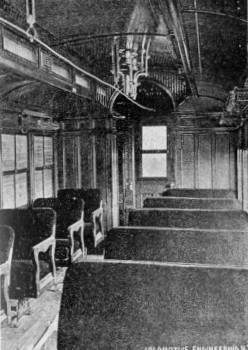T — ZTiffany Summer and Winter Car. (Has its own page.) Truck. A foreshortened form of the older, but more proper, term “car-truck,” denoting the wheeled apparatus supporting an 8-wheeled railway car. In some parts of the world perhaps more properly called a “bogie.” The small four-, six-, or sometimes even eight-wheeled car under each end of a typical North American railway car body that supports it and carries it down the track. Its purpose is to enable short wheel-bases to be used in connection with long car-bodies. Truck bolster. A cross piece, for many years made of timber, holding together the truck side-frames, and supporting the car body on the truck center-plate which is attached to its center. The truck bolster is connected to the body bolster by the center-pin about which the truck swivels. Truck center-plate. One of a pair of plates, originally made of cast iron, that support a car body on the center of its trucks. The center-pin passes through them but carries none of the strain except in emergencies, due to the male and female shape of the corresponding plates. Truck side bearing. The lower one of the two side bearings; the one that is attached to the truck bolster. Two-and-one seating. (below) The early narrow gauge cars were too narrow to have two double seats with a reasonable aisle, so they generally had a double seat on one side of the aisle and a single seat on the other. To keep the car “balanced,” this was reversed at the middle of the car, so that the double-seat side became the single-seat side. Here’s the interior of an early Barney & Smith car showing two-and-one seating:
Window lintel. A horizontal piece of wood on the outside of a passenger car between the window posts and over the window opening. Window post. The post at the side of a window opening against which the window sash slides, and which forms part of the frame of the side of the car body. Window sash. The frame that holds the window glass. Slides up and down between the window posts or, in the case of a deck sash, may pivot horizontally to encourage air flow. Window Sill. A horizontal piece of wood or metal under a window, on which the window sash rests when down (closed). It is usually tipped toward the outside so as to direct water in that direction. |
